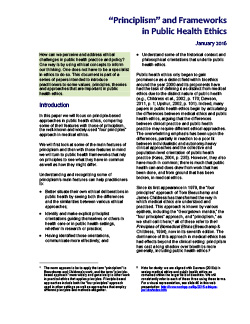“Principlism” and Frameworks in Public Health Ethics
In this paper we will focus on principle-based approaches in public health ethics, comparing some of their features with those of principlism, the well-known and widely-used “four principles” approach in medical ethics.
We will first look at some of the main features of principlism and then with those features in mind we will turn to public health frameworks that rely on principles to see what they have in common as well as how they might differ.
Understanding and recognizing some of principlism’s main features can help practitioners to:
- Better situate their own ethical deliberations in public health by seeing both the differences and the similarities between various ethical approaches;
- Identify and make explicit principlist orientations guiding themselves or others in health care or in public health settings, whether in research or practice;
- Having identified those orientations, communicate more effectively; and
- Understand some of the historical context and philosophical orientations that underlie public health ethics.
Public health ethics only began to gain prominence as a distinct field within bioethics around the year 2000 and its proponents have had the task of defining it as distinct from medical ethics due to the distinct nature of public health (e.g., Childress et al., 2002, p. 170; Dawson, 2011, p. 1; Upshur, 2002, p. 101). Indeed, many papers in public health ethics begin by articulating the differences between medical ethics and public health ethics, arguing that the differences between clinical practice and public health practice may require different ethical approaches. The overwhelming emphasis has been upon the differences, partially in reaction to a poor fit between individualistic and autonomy-heavy clinical approaches and the collective and population-level orientation of public health practice (Kass, 2004, p. 235). However, they also have much in common; there is much that public health can and does draw from work that has been done, and from ground that has been broken, in medical ethics.
Since its first appearance in 1979, the “four principles” approach of Tom Beauchamp and James Childress has transformed the way in which medical ethics are understood and practised. This approach is known by various epithets, including the “Georgetown mantra,” the “four principles” approach, and “principlism,” as we shall call it here;1 all of these refer to their Principles of Biomedical Ethics (Beauchamp & Childress, 1994), now in its seventh edition. The dominance of this approach in medical ethics has had effects beyond the clinical setting: principlism has cast a long shadow over bioethics more generally, including public health ethics.2
1 The norm appears to be to apply the term “principlism” to Beauchamp and Childress’s work, and the term “principle-based approach” more widely and generically to other work in practical ethics that applies principles. Principle-based approaches include both the “four principles” approach used in other settings as well as approaches that employ different principles and methods altogether.
2 Note for clarity: we are aligned with Dawson (2010a) in seeing medical ethics and public health ethics as contained within the larger field of bioethics. We will consistently refer to each of these three using these terms. For a visual representation, see slide #5 in this web presentation: http://www.ncchpp.ca/ftp/2015-ethique-pw1/en/index.htm


